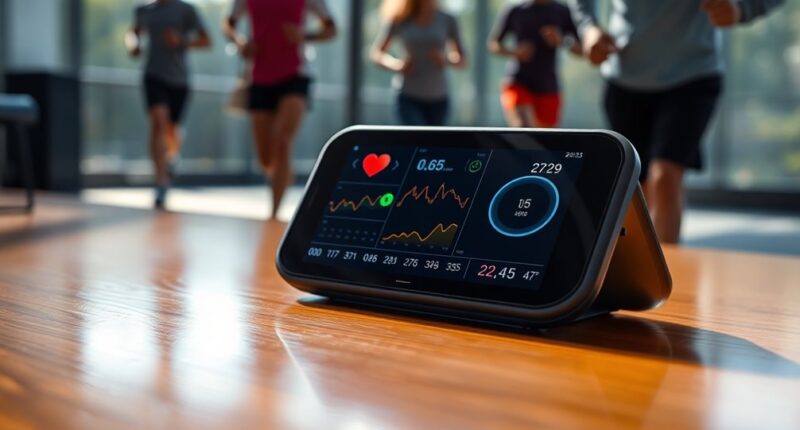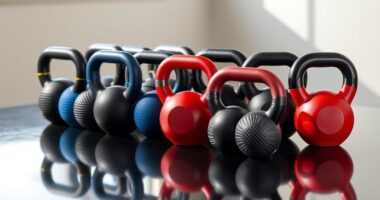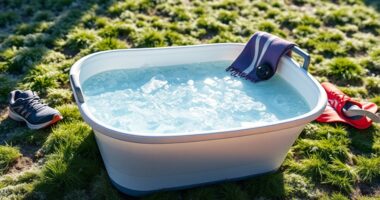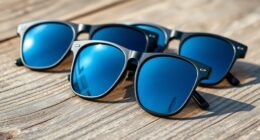When choosing the best running analytics device for 2025, I focus on metrics that really matter. Device accuracy, like distance and heart rate, should exceed 95% to guarantee effective training. I also look for solid GPS tracking and customizable data fields for personalized insights. Battery life and connectivity options are essential for seamless monitoring. If you're curious about how these features stack up against each other, I've got some great insights to share with you.
Key Takeaways
- Look for devices with over 95% accuracy in distance and pace tracking to ensure reliable training results.
- Choose models with heart rate monitors that maintain a maximum error margin of ±5 BPM for precise health metrics.
- Opt for GPS accuracy within 5 to 10 meters for reliable outdoor route measurements and performance analysis.
- Select devices with customizable data fields and synchronization options to tailor training experiences and access analytics easily.
- Consider the total cost of ownership, including purchase price and potential subscription fees, to assess value and ROI effectively.
Predictive HR Analytics with Excel
When it comes to selecting the best running analytics device of 2025, one key feature that stands out is its ability to provide real-time heart rate monitoring, which is essential for serious runners looking to optimize their training. Similarly, I found that the book on Predictive HR Analytics with Excel offers invaluable insights. It breaks down complex statistical methods into manageable concepts, making analytics accessible for everyone. With practical applications like sentiment analysis and attrition modeling, I felt empowered to apply these techniques immediately. The clear instructions and engaging style transformed my understanding, enhancing my skills in HR analytics markedly.
Best For: HR professionals and beginners looking to enhance their analytics skills and apply practical data-driven insights in their organizations.
Pros:
- Clear explanations of statistical methods and machine learning make the content accessible to readers with no prior knowledge.
- Practical applications such as sentiment analysis and attrition modeling empower users to implement analytics techniques immediately.
- Engaging writing style and structured approach enhance understanding and retention of complex concepts.
Cons:
- Some readers may find the reliance on Excel limiting compared to more advanced analytics software.
- The book may not delve deeply into theoretical concepts, which could leave some readers wanting more background information.
- Certain free Excel add-ins mentioned may require additional technical proficiency to install and use effectively.
Factors to Consider When Choosing Running Analytics and Metrics Devices
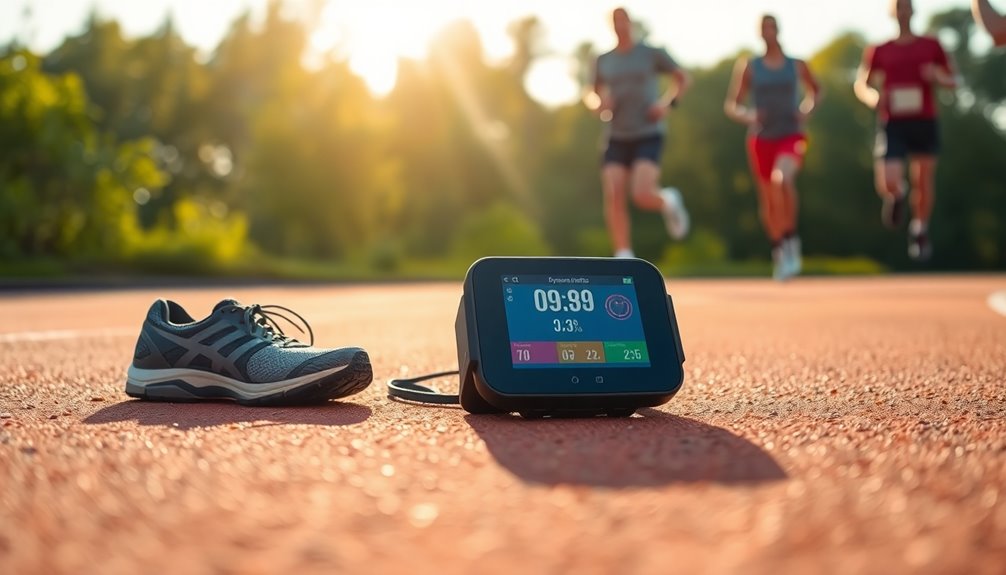
When choosing a running analytics device, I've found that several key factors really matter. You'll want to take into account device accuracy metrics, data tracking features, and how user-friendly the interface is. Plus, don't forget to look at connectivity options and battery life to ascertain it meets your running needs.
Device Accuracy Metrics
Choosing the right running analytics device hinges on a few key accuracy metrics that can greatly impact your training results. A high-quality device should boast over 95% accuracy in tracking distance and pace. When it comes to heart rate monitors, look for devices with a maximum error margin of ±5 BPM to guarantee reliable readings during your workouts. GPS accuracy is critical, too; a well-calibrated device should maintain positional accuracy within 5 to 10 meters under ideal conditions. Additionally, cadence accuracy is essential—aim for devices that capture steps per minute with less than 2% error. Finally, remember that calibration is important; adjusting for your height and stride length can considerably improve distance and speed accuracy, enhancing your overall performance metrics.
Data Tracking Features
While selecting a running analytics device, it's crucial to focus on the data tracking features that will best support your training journey. Look for devices that track key metrics like distance, pace, heart rate, and calories burned—these are essential for monitoring your performance. I recommend GPS tracking to accurately measure outdoor routes and provide real-time pace info, which can greatly enhance your training. Don't overlook recovery features like sleep tracking and heart rate variability, as they offer insights into your overall health. Customizable data fields are a must, allowing you to concentrate on metrics that align with your goals. Finally, verify the device can sync with mobile apps for easy access to detailed analytics and historical data.
User Interface Design
A great user interface (UI) can make all the difference in how effectively you interact with your running analytics device. I've found that a well-designed UI prioritizes clarity, letting me navigate and understand my data without confusion. Visual hierarchy is vital; it helps me quickly spot key metrics and analytics at a glance. Customizability is another fundamental factor—I love tailoring my dashboard to fit my preferences and analytical needs. Interactive elements, like filters and drill-down options, keep me engaged and allow for deeper data exploration. Finally, consistent design elements, such as cohesive color schemes and typography, guarantee I stay focused on the analytics, rather than getting distracted by mismatched styles.
Connectivity Options Available
When I evaluate running analytics devices, the range of connectivity options available is vital. I look for Bluetooth, Wi-Fi, and ANT+ capabilities, as they greatly enhance my experience. Bluetooth allows me to pair devices seamlessly with my smartphone, enabling instant data synchronization without the hassle of cables. Wi-Fi, on the other hand, accelerates data uploads to cloud services, giving me access to detailed analyses from anywhere. I also value ANT+ technology, which connects multiple sensors, like heart rate monitors and pace sensors, providing an all-encompassing view of my performance metrics during runs. Ultimately, reliable connectivity options help guarantee consistent data tracking, allowing me to focus on improving my running without interruptions.
Battery Life Considerations
How long can your running analytics device keep up with your workouts? Battery life is essential for uninterrupted training and data collection. Devices can last anywhere from 5 to 20 hours, depending on how intensely you use them and your settings. If you opt for a device with energy-efficient tech, you can enjoy features like continuous heart rate monitoring and GPS without constant recharges. Fitness trackers typically last 5 to 10 days, while smartwatches often last 1 to 3 days with active use. Remember, user settings like screen brightness and connectivity can drastically impact battery life. Consider models with battery-saving modes that disable non-essential features during workouts to strike the perfect balance between performance and endurance.
Price and Value Analysis
After considering battery life, the next important aspect to think about is the price and value of running analytics devices. It's vital to look at the total cost of ownership, which includes the initial purchase price, subscription fees, and any extra accessories or upgrades. I find that higher-priced models typically offer better accuracy and reliability, leading to more insightful performance metrics. Evaluating the return on investment (ROI) is significant—consider how the device can improve training efficiency, prevent injuries, and enhance your overall performance. I recommend looking for devices that bundle multiple features, like heart rate monitoring and GPS tracking, as they often provide better value. Finally, user reviews and expert ratings can help justify those higher price points.
Frequently Asked Questions
What Are the Top Brands for Running Analytics Devices in 2025?
When it comes to running analytics devices in 2025, I’ve found a few brands really stand out. Garmin continues to impress with its advanced features, while Polar offers solid options for serious athletes. Suunto’s durability and accuracy make it a favorite too. Finally, I can’t ignore Apple’s integration with other devices, which adds convenience. Each brand has its strengths, so it really depends on what you prioritize in your running journey! If you’re looking for the best running performance gadgets, it’s essential to consider your personal goals and preferences. For example, if you value detailed training metrics, Garmin’s advanced analytics might be your best bet. On the other hand, if you appreciate a seamless connection with your smartphone and other devices, Apple could be the perfect choice for optimizing your workouts. Whatever your needs, each brand offers options that cater to various aspects of a runner’s experience.
How Do Running Analytics Devices Connect With Other Fitness Apps?
You won't believe how seamlessly running analytics devices connect with fitness apps! It's like they're best friends, sharing secrets about your workouts. When I sync my device, it automatically uploads my run data to my favorite app, letting me track my progress effortlessly. I can analyze my pace, heart rate, and more. Honestly, it's a game-changer for anyone serious about their fitness journey and wanting to stay motivated and informed!
Can I Use Running Analytics Devices for Other Sports?
Absolutely, I've found that many running analytics devices can be used for other sports too. Most of them track metrics like heart rate, distance, and calories burned, which are relevant for activities like cycling or swimming. When I switch sports, I simply adjust the settings on my device or app. It's a great way to keep my workouts consistent and monitor my overall fitness progress, no matter what sport I'm doing!
What Is the Average Battery Life of Running Analytics Devices?
Battery life brims with benefits when it comes to running analytics devices. Typically, I've found that most devices offer anywhere from five to ten hours of usage on a single charge. Some high-end models might stretch that a bit longer, reaching up to 20 hours. It's essential to take into account your training schedule and how often you'll need to recharge. Trust me, a device that powers through your workouts is a game-changer!
Are There Subscription Fees Associated With Running Analytics Devices?
Absolutely, there can be subscription fees tied to running analytics devices. I've found that some brands offer premium features or exclusive data insights that require a monthly or yearly payment. It's important to check if the device you're considering has any ongoing costs. I always weigh the benefits against the fees to guarantee it's worth it for my training. After all, I want the best value for my running experience!
Conclusion
In wrapping up, choosing the right running analytics device can feel like searching for a needle in a haystack, but it's totally worth the effort. By focusing on accuracy, data tracking features, and user-friendly design, you'll find a device that not only meets your needs but also enhances your running experience. Remember, it's all about the metrics that matter to you. So lace up, get out there, and let the data guide your journey!
